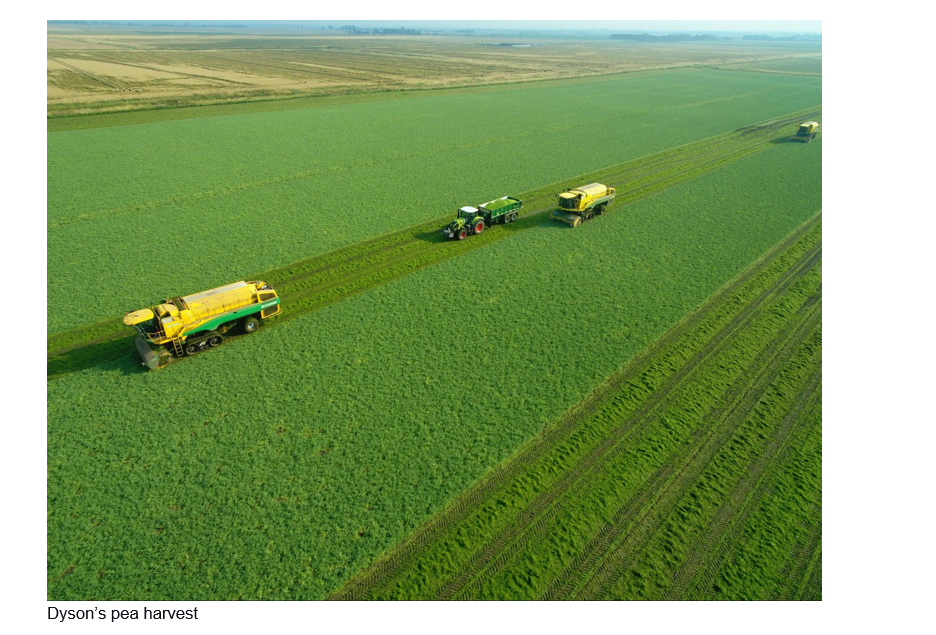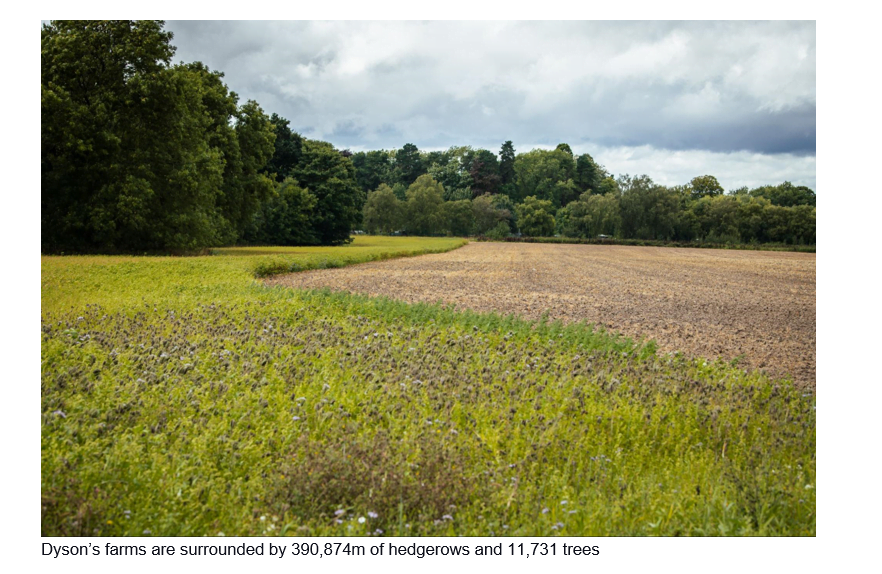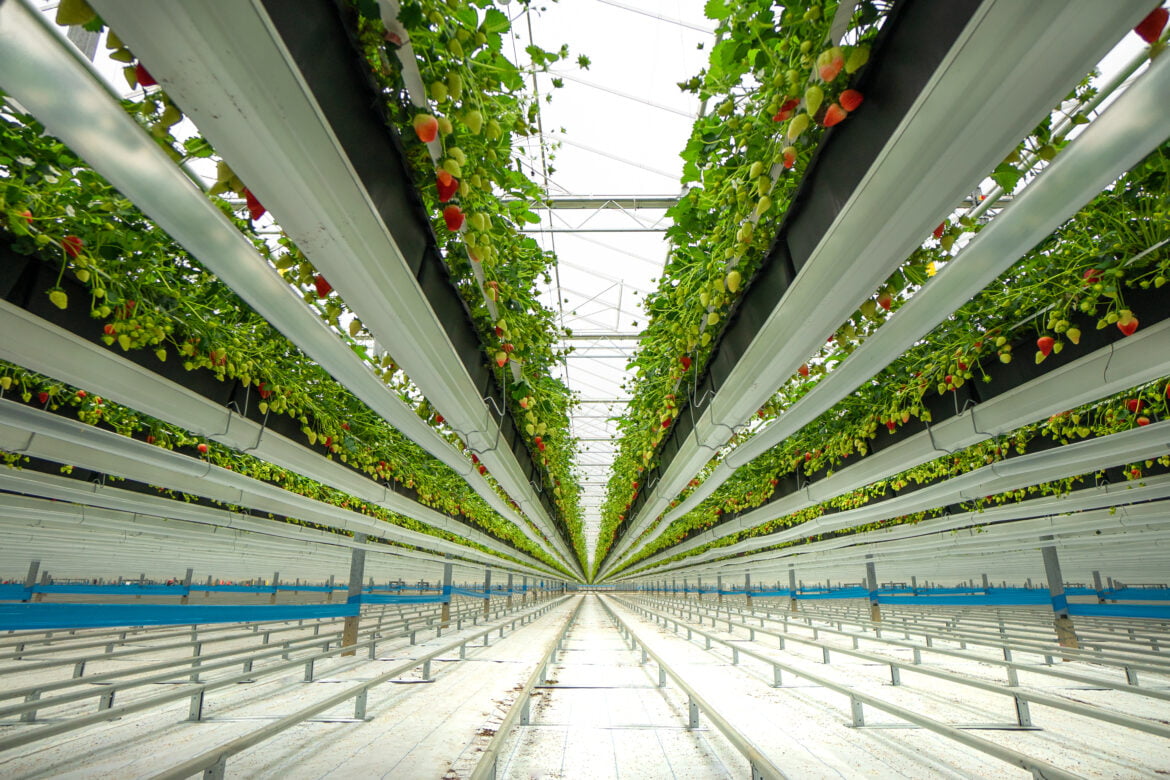The first thing that comes to mind when hearing the name Dyson is vacuums. After all, founder James Dyson has built an empire on the foundations of his household cleaning technology. But what you may not know is that Dyson also has an agricultural branch. Dyson Farming, founded in 2013, has hoovered up an impressive stretch of land, too, amounting to 36,000 acres across Lincolnshire, Gloucestershire, Oxfordshire and Somerset, as one of the UK’s top five growers.
Dyson is very much a company that believes in the power of tech to transform farming for the better and is using innovative approaches to bolster sustainability, facilitate food security and give back to the land.
ESG Mena’s lead journalist Madaline Dunn recently visited Dyson’s Carrington farm in Lincolnshire to experience first-hand its circular farming model and the role tech has in growing the future of food.
Leveraging tech for environmental protection and promoting regeneration
Tech innovation is at the heart of Dyson’s approach to farming, but that doesn’t mean that it’s out of step with nature. In fact, through a myriad of tech-informed approaches, Dyson is minimising its agricultural inputs and making data-informed decisions to preserve ecological habitats.
Ed Ford, Technology Manager, explained that the farm is using AI-assisted precision spraying technology, the first in the UK to do so commercially, for greater efficiency, productivity and environmental protection. Developed in conjunction with Bilberry, the technology uses a specialist camera network comprising 12 cameras to identify and spray herbicides on only targeted weeds. According to Ford, the application of this technology has resulted in a 70 – 90 per cent reduction in herbicide applications.

Alongside reducing its herbicide applications, the farm is also employing drone technology to identify and protect nesting species, such as the marsh harrier, which nests during harvest season. The drones locate the protected birds, the team geotags them in the field, and then sends the information to the harvester to ensure the nests are avoided. Ford shared that this year, 40 per cent of the breeding population was in Lincolnshire.
A dedicated environment team also conducts bird surveying to monitor numbers and assess landscape management activities, while also providing nesting boxes as part of its owl box scheme. Further, to promote biodiversity and support pollinators, the farms have 390,874m of hedgerows and 11,731 trees, alongside its agroforestry scheme at Little Steeping.

“This intricate web of habitats throughout the landscape provides food and shelter for insects and birds,” said Ian Willoughby, Estate Surveyor.
Soil health is also an important consideration for the farm, and the company is employing a number of regenerative practices on a large scale to assist with this. This includes the use of nitrogen-fixing legumes planted in rotation, such as vetch and microclovers.
As a major producer of peas, producing the equivalent of four million packets a year, the farm uses vining peas in its rotation before high-quality milling wheat. It also uses cover crops in the winter, to recycle nutrients, prevent erosion and enhance soil structure and biodiversity.
Food security and promoting provenance
The UK imports around 46 per cent of the total food it consumes, and when it comes to fruit and vegetables, this number is even higher, with 80 per cent of the UK’s fruit and almost half of all vegetables imported. This recently prompted the Sustainable and Healthy Food Systems (SHEFS) research group, to issue a warning that the UK needs to produce more of its own food, to avoid getting hit by high prices and supply chain issues resulting from climate change-induced droughts, water scarcity and conflict.
Of course, greater food sovereignty not only helps protect against scarcity and skyrocketing food prices, it also massively reduces food miles. According to research, global food miles contribute nearly 20 per cent of total food systems emissions, with fruit and vegetables accounting for the highest food miles emissions. Dyson’s farms are on a mission to change this, growing British crops for British consumption.
One way Dyson’s farms are working to meet the country’s demand for locally-produced fruit and vegetables is through its strawberry production, its pride and joy. Typically, in winter, strawberries are imported from Spain, Morocco, Egypt or Israel, however, Dyson now grows its own all year round in its 15-acre glasshouse in Carrington, amounting to 750 tonnes of strawberries a year.

The expansive glasshouse, powered by the company’s anaerobic digesters (more on that later), is 424m long and features 832 rows of strawberries and 700,000 strawberry plants. Utilising energy-efficient LED lighting, it creates the illusion of day and night for the strawberries, extending day length. Likewise, it uses a UV light robot to reduce the need for fungicide and deploys microscopic mites on the crops, which, Angel Angelov, Glasshouse Manager, said means that it uses 90% less pesticides. Its strawberries hit supermarket shelves for the first time in 2021, as part of an exclusive, first-of-its-kind deal with Marks & Spencer.
According to Dyson Farming, it is also working with the wider Dyson team to develop new growing techniques for higher strawberry production – although the details surrounding this are top secret, for the time being. That said, I did get the chance to witness the farm’s futuristic strawberry-picking robots in action.
The farm is currently piloting 18 machines, which can pick between three and four strawberries a minute. While not yet fast enough to keep up with its human counterparts, Dyson believes this tech can go some way to aid the labour shortage.
Centring circularity at the heart of farming
At the heart of Dyson’s farming operations are its two anaerobic digesters. Towering above the Carrington farm, they’re truly a sight to behold; as Steve Barker, Commercial Director, Dyson Farming says, they’re “the Rolls-Royce” of anaerobic digesters.

The ADs, which Barker likened to a big cow, facilitate much of the circularity at the farm. Fed maize and barley, the ADs produce digestate, organic matter which is used for fertilising crops, improving soil quality, land fertility and crop yields. The biomethane produced from the plants is enough to power 10,000 homes, 0.2 per cent of UK electricity, and is used to power the glasshouse and farm vehicles; grain is also dried with heat from the ADs.
In future, the company shared that the biomethane from the ADs will be captured and converted into biogas to use in green transport.
Reimagining the future of farming
As the world grapples with the climate crisis, to which agriculture is a huge contributor, there’s never been a greater need to trial new approaches and think outside the box; Dyson Farming is leading the way here in the UK.
From visiting its farms, it was clear that technology is not part of the problem but, instead, can be part of the solution, and help facilitate the transition to regenerative agriculture on a wider scale.
To scale this approach to the level required to transform our food systems, knowledge must be shared, key data democratised, and nature-positive and regenerative approaches incentivised and supported by government policy.



